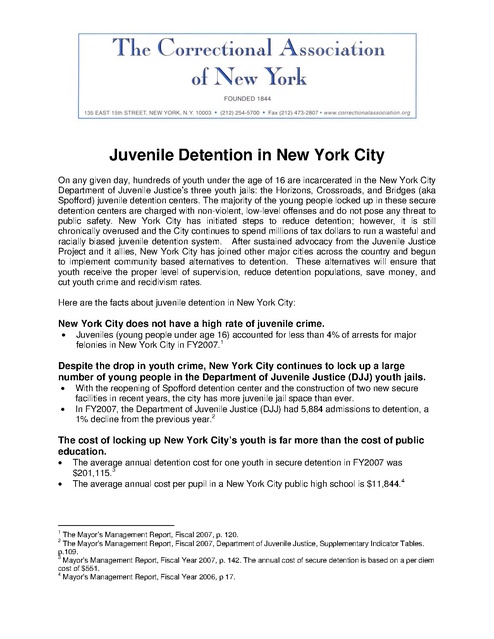Nyc-juvenile Detention Fact Nov 2007
Download original document:

Document text

Document text
This text is machine-read, and may contain errors. Check the original document to verify accuracy.
Juvenile Detention in New York City On any given day, hundreds of youth under the age of 16 are incarcerated in the New York City Department of Juvenile Justice’s three youth jails: the Horizons, Crossroads, and Bridges (aka Spofford) juvenile detention centers. The majority of the young people locked up in these secure detention centers are charged with non-violent, low-level offenses and do not pose any threat to public safety. New York City has initiated steps to reduce detention; however, it is still chronically overused and the City continues to spend millions of tax dollars to run a wasteful and racially biased juvenile detention system. After sustained advocacy from the Juvenile Justice Project and it allies, New York City has joined other major cities across the country and begun to implement community based alternatives to detention. These alternatives will ensure that youth receive the proper level of supervision, reduce detention populations, save money, and cut youth crime and recidivism rates. Here are the facts about juvenile detention in New York City: New York City does not have a high rate of juvenile crime. • Juveniles (young people under age 16) accounted for less than 4% of arrests for major felonies in New York City in FY2007.1 Despite the drop in youth crime, New York City continues to lock up a large number of young people in the Department of Juvenile Justice (DJJ) youth jails. • • With the reopening of Spofford detention center and the construction of two new secure facilities in recent years, the city has more juvenile jail space than ever. In FY2007, the Department of Juvenile Justice (DJJ) had 5,884 admissions to detention, a 1% decline from the previous year.2 The cost of locking up New York City’s youth is far more than the cost of public education. • • 1 The average annual detention cost for one youth in secure detention in FY2007 was $201,115.3 The average annual cost per pupil in a New York City public high school is $11,844.4 The Mayor’s Management Report, Fiscal 2007, p. 120. The Mayor’s Management Report, Fiscal 2007, Department of Juvenile Justice, Supplementary Indicator Tables. p.109. 3 Mayor’s Management Report, Fiscal Year 2007, p. 142. The annual cost of secure detention is based on a per diem cost of $551. 4 Mayor’s Management Report, Fiscal Year 2006, p 17. 2 A disproportionate number of children of color are jailed in DJJ’s secure detention facilities. • • African American and Latino youth comprise 95% of the youth entering detention, while they comprise less than two-thirds of all youth in New York City.5 White youth comprise 5% of detainees, while they comprise 25% of all children in New York City.6 A vastly disproportionate number of youth in detention come from the city’s poorest neighborhoods. • The neighborhoods with the highest rates of juvenile detention are East New York, South Jamaica, Bedford-Stuyvesant, Brownsville, Soundview, Morris Heights, Saint George, Harlem, East Harlem and the South Bronx.7 The neighborhoods with the highest rates of detention also have the highest levels of poverty, poor housing and under-performing schools.8 Most young people in secure facilities are alleged juvenile delinquents9, not juvenile offenders10 and hence were not charged with the most serious offenses. • In FY2006, 92% of youth entering secure detention facilities were classified as juvenile delinquents; 8% were classified as juvenile offenders.11 The majority of youth in detention were charged with non-violent offenses. • In FY2004, more than half the youth entering detention were charged non-violent offenses including misdemeanors and technical violations.12 The city’s youth jails have high recidivism rates. • In FY2007, 46% of the youth released from DJJ facilities were readmitted to detention in the same year. 13 In the summer of 2007, NYC began implementing a continuum of communitybased alternatives to detention for court-involved youth in Family Court. • 5 6 7 New York City has partnered with several non-profit organizations to create new alternative to-detention programs. The new ATD programs will cost $15,000 per youth per year, significantly less than the $200,000 it currently costs to house a youth in secure detention.14 NYC Department of Juvenile Justice, 2001. Ibid. NYC Department of Juvenile Justice, 2007. 8 Keeping Track of New York City’s Children, Citizens Committee for Children, 2005 9 A juvenile delinquent is a young person, aged 7 through 15, charged with committing an act that would constitute a crime if committed by an adult. Delinquency cases are heard in Family Court. 10 A juvenile offender is a young person, aged 13 through 15, who is charged with committing one of a list of 15 specified serious felonies and is tried in adult criminal court. All alleged juvenile offenders must be held in secure detention facilities awaiting trial, unless bail is set. 11 “By the Numbers” Department of Juvenile Justice Website 2007. http://www.nyc.gov/html/djj/pdf/admi_detention_by_charge.pdf 12 NYC Department of Juvenile Justice, 2004. 13 Mayor’s Management Report, Fiscal Year 2007, p.142. 14 This cost was calculated based on a program with 40 slots and an annual budget of $600,000.





